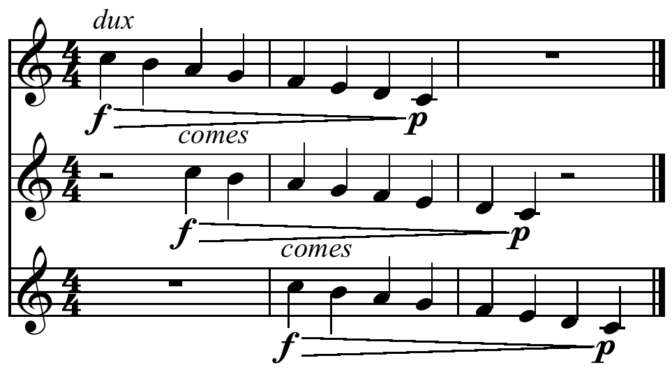Dynamics
An illustration of hairpins in musical notation.
In music, „dynamics“ normally refers to variations of intensity or volume, as may be measured by physicists and audio engineers in decibels or phons. In music notation, however, dynamics are not treated as absolute values, but as relative ones. Because they are usually measured subjectively, there are factors besides amplitude that affect the performance or perception of intensity, such as timbre, vibrato, and articulation.
The conventional indications of dynamics are abbreviations for Italian words like forte (f) for loud and piano (p) for soft. These two basic notations are modified by indications including mezzo piano (mp) for moderately soft (literally „half soft“) and mezzo forte (mf) for moderately loud, sforzando or sforzato (sfz) for a surging or „pushed“ attack, or fortepiano (fp) for a loud attack with a sudden decrease to a soft level. The full span of these markings usually range from a nearly inaudible pianissississimo (pppp) to a loud-as-possible fortissississimo (ffff).
Greater extremes of pppppp and fffff and nuances such as p+ or più piano are sometimes found. Other systems of indicating volume are also used in both notation and analysis: dB (decibels), numerical scales, colored or different sized notes, words in languages other than Italian, and symbols such as those for progressively increasing volume (crescendo) or decreasing volume (decrescendo), often called „hairpins“ when indicated with diverging or converging lines as shown in the graphic above.
Articulation
Articulation is the way the performer sounds notes. For example, staccato is the shortening of duration compared to the written note value, legato performs the notes in a smoothly joined sequence with no separation. Articulation is often described rather than quantified, therefore there is room to interpret how to execute precisely each articulation.
For example, staccato is often referred to as „separated“ or „detached“ rather than having a defined or numbered amount by which to reduce the notated duration. Violin players use a variety of techniques to perform different qualities of staccato. The manner in which a performer decides to execute a given articulation is usually based on the context of the piece or phrase, but many articulation symbols and verbal instructions depend on the instrument and musical period (e.g. viol, wind; classical, baroque; etc.).
There are a set of articulations that most instruments and voices perform in common. They are—from long to short: legato (smooth, connected); tenuto (pressed or played to full notated duration); marcato (accented and detached); staccato („separated“, „detached“); martelé (heavily accented or „hammered“). Many of these can be combined to create certain „in-between“ articulations. For example, portato is the combination of tenuto and staccato. Some instruments have unique methods by which to produce sounds, such as spicatto for bowed strings, where the bow bounces off the string.



